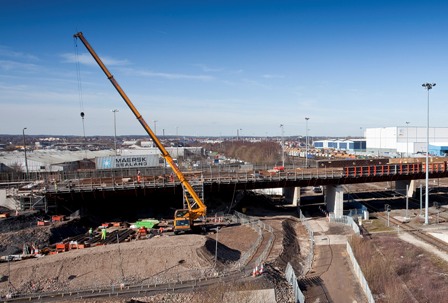MSF1 – Early Contractor Involvement – Doncaster Southern Gateway
“The Early Contractor Involvement phase allowed the experience of the team to challenge the design and develop a methodology which resulted in making significant savings of nearly 10% of the £32m build.”
Project: Doncaster Southern Gateway Client: Doncaster Metropolitan Borough Council
Partner/Associate: Balfour Beatty Civil Engineering Contract Value: £32 million
Length of Project: Approx 2 years Completion date: 7 June 2013 – 3 weeks ahead of schedule
Background:
The A6182 White Rose Way scheme extends from Junction 3 of the M18 south of Doncaster to Ladybank roundabout. This section is the main north/south route to the south of Doncaster. The A6182, at the time, had insufficient capacity for the traffic flow. Queues during peak hours regularly extend onto the M18 via Junction 3 and occasionally, back to the A1.
Objectives:
The scheme upgraded 1.9 km of existing carriageway to dual carriageway standard with objectives to enable regeneration and alleviate congestion issues. Changing to a dual carriageway standard required the construction of a second bridge over the existing East Coast Main Line to accommodate the new southbound carriageway. Congestion was also being caused by a lack of high capacity signalised junctions and roundabouts. Both the Potteric Carr and Ladybank roundabouts were reconstructed as part of this project. This included new crossings, cycleway and footway routes which were able to link to existing routes around Lakeside making the area, as a whole, more accessible and user friendly for all.
Key achievements:
Liaising with multiple stakeholders allowed us to have better communications and minimalized disruption to the public. Prioritising local suppliers helped the sustainability of the project as transportation was reduced. We took positive steps to reduce consumption in all areas of the project for example, using recycled materials, monitoring the energy usage and training staff. Being sustainable with the use of materials meant we were able to reduce the carbon footprint and dependency of resources.
With high capacity signalised junctions we improved the safety and the pedestrians and cycle facilities. The installation of the dual carriageway meant congestion was reduced and better access was available to get to the airport and the Lakeside development.
Detailed and thorough training on the project also resulted in a number of further successes – especially in employment and skills.
■ Four vacancies filled through advertisements with local employment vehicles.
■ One graduate employed.
■ Eight people employed by subcontractors who started and completed NVQ level 2.
■ Four work experience placements (minimum of two weeks) provided for 16-19 year olds and five NSAfC placements for 14-16 year olds.
■ ‘Ambassador Training – Professional’ to promote the sector completed by eight members of staff.
■ Training and awareness of the modern construction industry provided to 12 teachers.
■ 210 school pupils participated in ‘Curriculum Support Events’ which included ‘Careers Speed Dating’, job fairs and teen tech days.
■ Site visits were hosted from four schools, covering 38 year ten students.
■ 14 members of subcontractors’ staff now have CSCS/CPCS cards.
■ Short courses were provided for 16 employees and 13 subcontractor employees.
Finances:
The contract value totalled at £32 million and was broken down as follows:
European Regional Development Fund (ERDF) £10.1m
Department for Transport £9.7m
Doncaster Council £7.3
Sheffield City Region Transport Strategy £3.7m
Private Sector £1.4
Looking to the future:
Balfour Beatty Civil Engineering brought its knowledge of the rail process to the project as it has a detailed understanding of working within a live railway environment. Also, by having early contractor involvement (ECI), it meant Balfour Beatty could work in partnership with the local council and their design team to help finalise the design and buildability. The ECI phase allowed the experience of the team to challenge the design and develop a methodology which resulted in making significant savings of nearly 10% of the £32m build.
Liaising with multiple stakeholders allowed us to have better communication and minimalise disruption to the public. Prioritising local suppliers helped the sustainability of the project as transportation was reduced and the use of recyclable materials meant our carbon footprint was low. These are some of the key highlights we hope to replicate in future projects.
